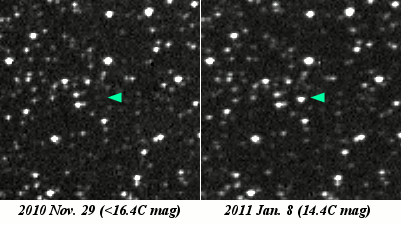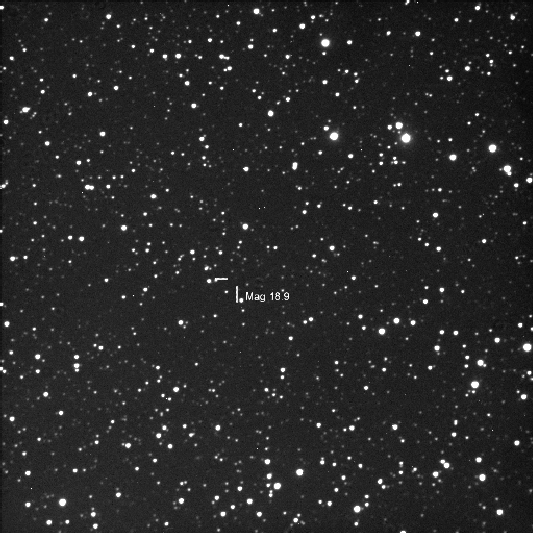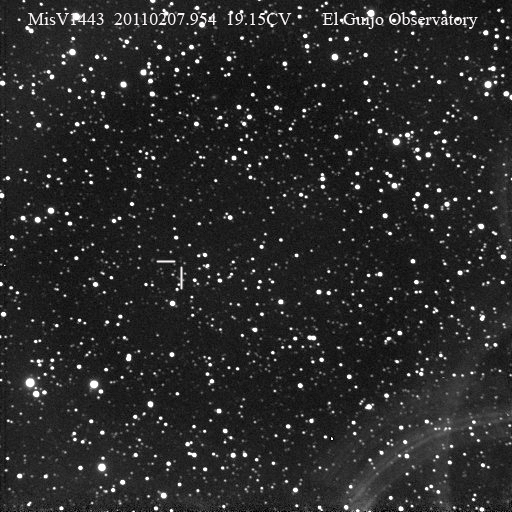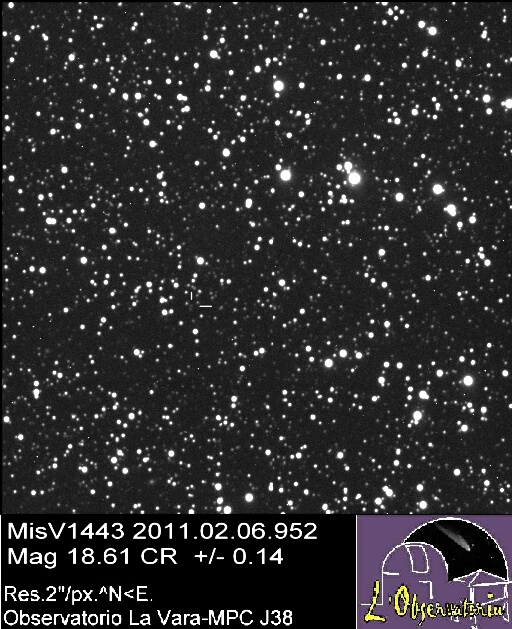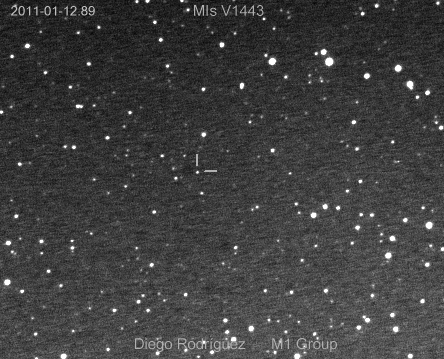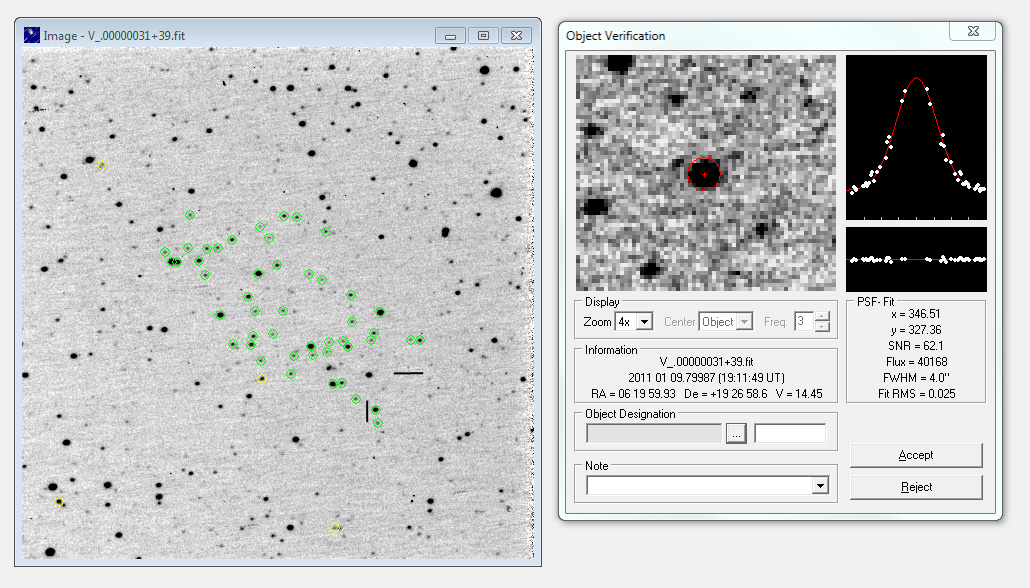Japanese version Home Page Updated on August 7, 2016
MisV1443: Discovery of Bright Dwarf Nova in Orion
2011 Nov. 6 On January 10, 2011, we the MISAO Project discovered a bright dwarf nova, which reached up to 12.8 mag at brightest, in Orion from the survey images taken by Youichirou Nakashima.
| |||||||||||||||||||||||||||||||||||||||||||||||||||||
| This research has made use of the NASA/ IPAC Infrared Science Archive, which is operated by the Jet Propulsion Laboratory, California Institute of Technology, under contract with the National Aeronautics and Space Administration. |
Yoshida noticed this new object soon after midnight on Jan. 10, 2011 (JST). Ken-ichi Kadota and Yasukazu Ikari, MISAO Project, replied immediately, but we could not confirm the object in Japan due to the bad weather. However, this object was visible on three images on Jan. 8 and seems to be real. Because it is highly likely to be a nova or cataclysmic variable, Yoshida post the discovery to VSNET and called for confirmation. Yoshida also reported it to the Central Bureau for Astronomical Telegrams, and this object was listed up in the Transient Objects Confirmation Page (TOCP).

MisV1443 listed up in CBAT Transient Objects Confirmation Page
Immdediately, this object was observed and confirmed by Gianluca Masi (Italy) and Nick James (United Kingdom). Youichirou Nakashima could also confirm this object on Jan. 9.84 (UT), although it was extremely low and poor condition to measure the magnitude.
| Observer | Date and Time | Magnitude | R.A. | Decl. |
|---|---|---|---|---|
| Gianluca Masi | Jan. 9.76819 | 14.1 (unfiltered, R-dominated) | 59s.93 | 58".7 |
| Nick James | Jan. 9.800: | 14.38 (V) 14.36 (Rc) 14.53 (Ic) | 59s.93 | 58".6 |
Ken-ichi Kadota found that this object is recorded in the USNO-B1.0 catalog at 20 mag. Only blue magnitude is recorded.
| USNO-B1.0 1094-0104214 | |
| R.A. | 06h19m59s.9113 |
| Decl. | +19o26'59".210 |
| B1 mag | 20.480 |
| B2 mag | 20.390 |
Brian Skiff found that this object is recorded in the GSC-2.3 catalog. The SuperCOSMOS scan of the same plate shows the blue magnitude 20.56.
| GSC2.3 N8JR031714 | |
| R.A. | 06h19m59s.93 |
| Decl. | +19o26'58".8 |
| Blue mag | 20.56 |
| Epoch | 1996.112 |
In the Digitized Sky Survey POSS-II plates, a faint star is visible at this position on the blue image. But only a hint of this object, nearly noise level, is visible on the red image. Nothing is visible on the infrared image.
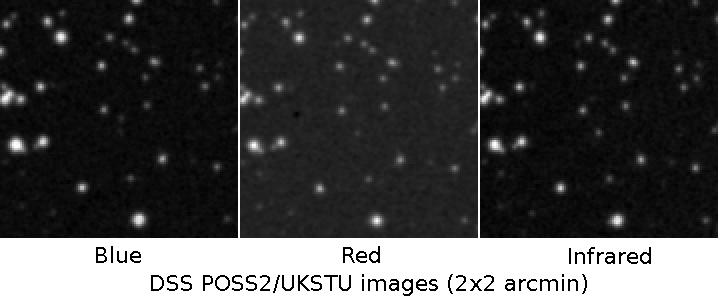
Digitized Sky Survey POSS-II plates
| Blue | 1996 Feb. 14 03:42(UT) |
| Red | 1996 Oct. 9 11:00(UT) |
| Infrared | 1994 Nov. 27 08:23(UT) |
|
The Digitized Sky Surveys were produced at the Space Telescope Science Institute under U.S. Government grant NAG W-2166. The images of these surveys are based on photographic data obtained using the Oschin Schmidt Telescope on Palomar Mountain and the UK Schmidt Telescope. The plates were processed into the present compressed digital form with the permission of these institutions. The Second Palomar Observatory Sky Survey (POSS-II) was made by the California Institute of Technology with funds from the National Science Foundation, the National Geographic Society, the Sloan Foundation, the Samuel Oschin Foundation, and the Eastman Kodak Corporation. The UK Schmidt Telescope was operated by the Royal Observatory Edinburgh, with funding from the UK Science and Engineering Research Council (later the UK Particle Physics and Astronomy Research Council), until 1988 June, and thereafter by the Anglo-Australian Observatory. The blue plates of the southern Sky Atlas and its Equatorial Extension (together known as the SERC-J), as well as the Equatorial Red (ER), and the Second Epoch [red] Survey (SES) were all taken with the UK Schmidt. |
Hidetaka Sato obtained the multi band photometry of MisV1443 at Jan. 10.109(UT) using a remote telescope near Mayhill, NM, and confirmed that MisV1443 is a whilte star.
| Band | Magnitude |
|---|---|
| B | 14.48 |
| V | 14.49 |
| Rc | 14.57 |
| Ic | 14.62 |
Akira Arai obtained a low-resolution spectrum of MisV1443 on 10 Jan. using 1.3m Araki telescope at Kyoto Sangyo University. The spectrum of MisV1443 shows broad balmer absorption lines and the weak Ha emission line (http://www.cc.kyoto-su.ac.jp/~kao/blog/index.php/view/32), which is consistent with that by 1.82-m Plaskett telescope on the same day. These features indicate that MisV1443 would be a dwarf nova in outburst.
Enrique de Miguel reported that after a ~4.2-hour time series, this object exhibits sort of double-hump oscillations, with full amplitude ~0.08 mags. Taichi Kato (Kyoto University) pointed out that the present variation is most likely early superhumps of a WZ Sge-type dwarf nova.
But after that, Hiroyuki Maehara obtained a long time-series run. The data showed fully developed superhumps (0.25-0.30 mag). The relatively large amplitude of superhumps might suggests that the object is not a very extreme WZ Sge-type dwarf nova.
Time series photometry of MisV1443 by Hidehiko Akazawa (Kurashiki, Okayama, Japan).
http://akazawa-hide.sakura.ne.jp/MisV1443/MisV1443.htm
Stanislav Korotkiy and Kirill Sokolovsky found that this object was visible at 12.8 mag on their images on Jan. 2, 2011 (http://scan.sai.msu.ru/~kirx/transients/new_object_in_Gem/). It revealed that the MISAO Project discovered this object about one week after the explosion, and the object has already faded by about 2 mag.
This dwarf nova has been fading gradually until Jan. 24 down to 16 mag. But suddenly on Jan. 28, Roger Pickard reported that it faded rapidly down to 18.5 mag. Then Adolfo San Segundo observed its re-brightening up to 15.32 mag on Feb. 3. However, it faded out rapidly again. It became fainter than 16 mag on the next day, and fainter than 18 mag within 3 days, on Feb. 6. No further brightening of this object has been observed since that.
We received so many observations, images, and grateful congratulations on this discovery of this dwarf nova. We sincerely appreciate your contributions and messages.
Our discovery was announced in CBET 2633.
Taichi Kato, Kyoto University, et al., published the paper.
PASJ: Publ. Astron. Soc. Japan 64, 21 (Feb. 25, 2012)
Survey of Period Variations of Superhumps in SU UMa-Type Dwarf Novae. III: The Third Year (2010--2011)
Published PDF
T. Kato, et al.
(Supplement on November 10, 2011)
AAVSO star chart is available.
Variable Star Plotter (VSP)
http://www.aavso.org/vsp
* Please input the object name "Mis V1443", a space is required.
 Light Curve
Light Curve
(Updated on Nov. 6, 2011)
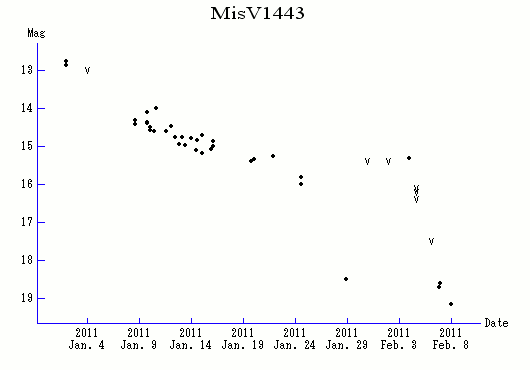
 Recent Observations
Recent Observations
(Updated on Aug. 7, 2016)
Here includes the observations reported to VSNET.
2012 Dec. 9.006 21.43 CV Adolfo San Segundo 2012 Sept.26.75473 [16.0 C Youichirou Nakashima 2012 Sept.26.75338 [16.3 C Youichirou Nakashima 2012 Sept.26.75201 [16.2 C Youichirou Nakashima 2012 Mar. 26.45375 [13.3 C Nobuo Ohkura 2012 Mar. 26.45236 [13.2 C Nobuo Ohkura 2012 Mar. 26.45097 [13.5 C Nobuo Ohkura 2012 Mar. 11.45669 [13.2 C Nobuo Ohkura 2012 Mar. 11.45530 [13.1 C Nobuo Ohkura 2012 Mar. 11.45391 [13.6 C Nobuo Ohkura 2012 Feb. 26.49890 [13.0 C Nobuo Ohkura 2012 Feb. 26.49751 [13.5 C Nobuo Ohkura 2012 Feb. 26.49612 [13.5 C Nobuo Ohkura 2012 Feb. 18.54091 [13.3 C Nobuo Ohkura 2012 Feb. 18.53953 [13.3 C Nobuo Ohkura 2012 Feb. 9.57037 [15.9 C Youichirou Nakashima 2012 Feb. 9.56902 [15.6 C Youichirou Nakashima 2012 Jan. 25.66192 [16.1 C Youichirou Nakashima 2012 Jan. 25.66059 [16.2 C Youichirou Nakashima 2012 Jan. 25.65925 [16.3 C Youichirou Nakashima 2012 Jan. 3.986 18.03 CV Adolfo San Segundo 2012 Jan. 3.986 17.66 CR Adolfo San Segundo 2011 Nov. 25.147 20.12 CR Adolfo San Segundo 2011 Nov. 21.64797 [15.8 C Youichirou Nakashima 2011 Nov. 21.64663 [16.0 C Youichirou Nakashima 2011 Nov. 21.64529 [16.1 C Youichirou Nakashima 2011 Nov. 7 [18.9 CR Faustino Garcia 2011 Apr. 1.916 [17.50 V Miguel Rodriguez Marco 2011 Mar. 31.919 [17.50 V Miguel Rodriguez Marco 2011 Mar. 4.57287 [16.0 C Youichirou Nakashima 2011 Mar. 4.57154 [15.9 C Youichirou Nakashima 2011 Mar. 4.57020 [16.1 C Youichirou Nakashima 2011 Feb. 7.954 19.15 CV Adolfo San Segundo 2011 Feb. 6.952 18.61 CR Faustino Garcia 2011 Feb. 6.848 18.70 CV Diego Rodriguez 2011 Feb. 6.067 [17.50 V Miguel Rodriguez Marco 2011 Feb. 4.60115 [16.2 C Youichirou Nakashima 2011 Feb. 4.59980 [16.1 C Youichirou Nakashima 2011 Feb. 4.59846 [16.4 C Youichirou Nakashima 2011 Feb. 3.956 15.32 CV Adolfo San Segundo 2011 Feb. 1.958 [15.4 visual Gary Poyner (VSNET) 2011 Jan. 30.912 [15.4 visual Gary Poyner (VSNET) 2011 Jan. 28.899 18.5 C Roger Pickard (VSNET) 2011 Jan. 24.58850 16.0 C Youichirou Nakashima 2011 Jan. 24.58712 16.0 C Youichirou Nakashima 2011 Jan. 24.58575 15.8 C Youichirou Nakashima 2011 Jan. 21.882 15.25 CV Adolfo San Segundo 2011 Jan. 20.074 15.34 V Eddy Muyllaert (VSNET) 2011 Jan. 19.810 15.4 C Ian Miller (VSNET) 2011 Jan. 16.145 14.98 V Miguel Rodriguez Marco 2011 Jan. 16.087 14.86 C Eddy Muyllaert (VSNET) 2011 Jan. 15.876 15.08 CR Faustino Garcia 2011 Jan. 15.103 14.69 C Gary Poyner (VSNET) 2011 Jan. 15.102 15.19 V Miguel Rodriguez Marco 2011 Jan. 14.619 14.84 C Hiroshi Itoh (VSNET) 2011 Jan. 14.521 15.1 C Hiroyuki Maehara (VSNET) 2011 Jan. 14.514 [13.9 C Koichi Nishiyama and Fujio Kabashima 2011 Jan. 13.985 14.79 CR Faustino Garcia 2011 Jan. 13.458 14.97 C Seiichiro Kiyota (VSNET) 2011 Jan. 13.108 14.76 V Miguel Rodriguez Marco 2011 Jan. 12.893 14.94 CV Diego Rodriguez 2011 Jan. 12.439 14.75 C Seiichiro Kiyota (VSNET) 2011 Jan. 12.106 14.47 C Gary Poyner 2011 Jan. 11.636 14.6 C Hiroyuki Maehara (VSNET) 2011 Jan. 10.627 14.0 C Hiroyuki Maehara (VSNET) 2011 Jan. 10.432 14.60 C Seiichiro Kiyota (VSNET) 2011 Jan. 10.109 14.62 Ic Hidetaka Sato 2011 Jan. 10.109 14.57 Rc Hidetaka Sato 2011 Jan. 10.109 14.49 V Hidetaka Sato 2011 Jan. 10.109 14.48 B Hidetaka Sato 2011 Jan. 9.800: 14.53 Ic Nick James 2011 Jan. 9.800: 14.36 Rc Nick James 2011 Jan. 9.800: 14.38 V Nick James 2011 Jan. 9.76819 14.1 CR Gianluca Masi 2011 Jan. 9.498 [13.8 C Koichi Nishiyama and Fujio Kabashima 2011 Jan. 8.59981 14.3 C Youichirou Nakashima 2011 Jan. 8.59844 14.4 C Youichirou Nakashima 2011 Jan. 8.59707 14.4 C Youichirou Nakashima 2011 Jan. 6.669 [13.8 C Koichi Nishiyama and Fujio Kabashima 2011 Jan. 3.98212 [13 C Stanislav Korotkiy and Kirill Sokolovsky 2011 Jan. 3.98142 [13 C Stanislav Korotkiy and Kirill Sokolovsky 2011 Jan. 2.552 [13.9 C Koichi Nishiyama and Fujio Kabashima 2011 Jan. 2.01942 12.87 C Stanislav Korotkiy and Kirill Sokolovsky 2011 Jan. 2.01876 12.76 C Stanislav Korotkiy and Kirill Sokolovsky 2010 Dec. 24.601 [13.8 C Koichi Nishiyama and Fujio Kabashima 2010 Dec. 10.06512 [14 C Stanislav Korotkiy and Kirill Sokolovsky 2010 Dec. 9.06773 [14 C Stanislav Korotkiy and Kirill Sokolovsky 2010 Dec. 8.0305 [14 C Stanislav Korotkiy and Kirill Sokolovsky 2010 Dec. 6.99535 [14 C Stanislav Korotkiy and Kirill Sokolovsky 2010 Dec. 6.99466 [14 C Stanislav Korotkiy and Kirill Sokolovsky 2010 Nov. 29.77296 [16.3 C Youichirou Nakashima 2010 Nov. 29.77163 [16.4 C Youichirou Nakashima 2010 Nov. 29.77029 [16.4 C Youichirou Nakashima 2000 Feb. 27.55270 [16.1 C Nobuo Ohkura 2000 Feb. 27.55083 [16.1 C Nobuo Ohkura
|

